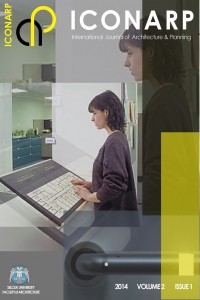Öz
Universal design approach aims to design products and environments that provide equal access for everyone to the variety of activities. Universal design applications and research and discussions related to these applications can be seen in different fields very often especially in the last years. Concerning the fact that its possibility of application is very new in Turkey, on the one hand, one of the aims of this study is to introduce and explain this new approach. On the other hand, the study aims to exemplify how the new information related to the philosophy of universal design approach can be integrated to the design education and find the ways of application in the university environment where the next expert generation has been coached. Within this framework, it is aimed to introduce the content and the way of application of the course of “Universal Design” which have been taught in the curriculum of the Architecture and Interior Architecture Departments of Okan University. Within the scope of the course, the students are expected to investigate and analyze the reflections of seven principles of universal design in real-life settings for the different and varied groups of human beings. While integrating the universal design approach to the design education, the things that is wanted to be emphasized is, this new and different approach is an inspiring fact for the new generation of designers concerning the concepts of accessibility and equality. The designs, organizations, suggestions, studies and researches of the design students of the course has demonstrated that if the universal design principles has become a component of the design education, it would also be achieving as a rewarding and fostering attempt.
Anahtar Kelimeler
Universal Design; Universal Design Principles; Okan University; “Universal Design” Course
Kaynakça
- Cavington, G. & Hannah, B. (1997). Access by Design. New York: Van Nostrand Reinhold. Center for Universal Design.
- http://www.ncsu.edu/project/design-projects/udi/>. (29 April
- 2013).< Demirkan, H. (2011). “Tasarım Eğitiminde Herkes için Tasarım Yaklaşımı: Tasarım Deneyimleri ve Uygulamaları”. Herkes için Tasarım Müfredatı Geliştirme Çalıştayı, Anadolu Üniversitesi, Eskişehir, 16-17 Haziran.
- Ergenoğlu, A. ve Yıldız, S. (2009). “Fiziksel Çevre ve Ulaşıma Erişilebilirlik” Farklı Açılardan Engellilik Projesi-Çalışma Grubu. Sabancı Üniversitesi.
- Erkılıç, M. (2011). “Conceptual Challenges between Universal Design and Disability in Relation to the Body, Impairment and the Environment: Where Does the Issue of Disability Stand in the Philosophy of UD?” METU JFA, 28(2), pp. 181-203.
- Hacıhasanoğlu, I. (2003). “Evrensel Tasarım”. Tasarım Kuram, 3, pp.93-101.
- Jones, M. & Sanford, J. (1996). “People with mobility impairments in US today and in 2010”. Assistive Technology, 8.1, pp.43-53.
- Olguntürk, N. & Demirkan, H. (2009). “Ergonomics and universal design in interior architecture education”. METU JFA, 26(2), pp.123-138. Ostroff, E. (2010). “Universal Design: An Evolving Paradigm”< http://www.mhprofessional.com/downloads/products
- /0071629238/0071629238Pdf. >. 09 Temmuz 2013.
- Robinett, M. (1985). Barrier Free Exterior Design: Anyone can Go Anywhere. New York: Van Nostrand Reinhold.
- Story, M. F., Mueller, J. L., & Mace, R. L. (1998). The Universal Design File. NC State University: The Center for Universal Design. RESUME
Öz
Kaynakça
- Cavington, G. & Hannah, B. (1997). Access by Design. New York: Van Nostrand Reinhold. Center for Universal Design.
- http://www.ncsu.edu/project/design-projects/udi/>. (29 April
- 2013).< Demirkan, H. (2011). “Tasarım Eğitiminde Herkes için Tasarım Yaklaşımı: Tasarım Deneyimleri ve Uygulamaları”. Herkes için Tasarım Müfredatı Geliştirme Çalıştayı, Anadolu Üniversitesi, Eskişehir, 16-17 Haziran.
- Ergenoğlu, A. ve Yıldız, S. (2009). “Fiziksel Çevre ve Ulaşıma Erişilebilirlik” Farklı Açılardan Engellilik Projesi-Çalışma Grubu. Sabancı Üniversitesi.
- Erkılıç, M. (2011). “Conceptual Challenges between Universal Design and Disability in Relation to the Body, Impairment and the Environment: Where Does the Issue of Disability Stand in the Philosophy of UD?” METU JFA, 28(2), pp. 181-203.
- Hacıhasanoğlu, I. (2003). “Evrensel Tasarım”. Tasarım Kuram, 3, pp.93-101.
- Jones, M. & Sanford, J. (1996). “People with mobility impairments in US today and in 2010”. Assistive Technology, 8.1, pp.43-53.
- Olguntürk, N. & Demirkan, H. (2009). “Ergonomics and universal design in interior architecture education”. METU JFA, 26(2), pp.123-138. Ostroff, E. (2010). “Universal Design: An Evolving Paradigm”< http://www.mhprofessional.com/downloads/products
- /0071629238/0071629238Pdf. >. 09 Temmuz 2013.
- Robinett, M. (1985). Barrier Free Exterior Design: Anyone can Go Anywhere. New York: Van Nostrand Reinhold.
- Story, M. F., Mueller, J. L., & Mace, R. L. (1998). The Universal Design File. NC State University: The Center for Universal Design. RESUME
Ayrıntılar
| Birincil Dil | İngilizce |
|---|---|
| Bölüm | Makaleler |
| Yazarlar | |
| Yayımlanma Tarihi | 8 Ağustos 2014 |
| Yayımlandığı Sayı | Yıl 2014 Cilt: 2 Sayı: 1 |


